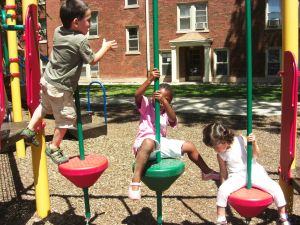

Tips to Keep Kids Safe When Playing Outside
Whether the season is summer, winter, autumn, or spring, outdoor play is an important part of childhood. Your children need to get outside and connect with their bodies and their world as much as they need to develop their minds in school. But unlike schoolwork, outdoor play can present physical dangers that you may find downright disturbing.
Children can easily fall and hurt themselves, play dangerous games that result in harm to others, or even become targets for adult predators outside. So how can you allow your children the outdoor exercise they need without either stifling them or signing them up for an unplanned trip to the emergency room?
Keep an Eye On Things
There are a few simple rules that every parent and their children should follow when it comes to outdoor play. These rules will make an enjoyable experience possible without exposing your child to any untoward dangers. The most important rule, of course, is that of adult supervision. If an adult is on hand to monitor the situation and deal with potential dangers as they crop up, then your child will be much less likely to come away from the backyard or the playground with a new scar to add to their growing collection.
Parental supervision can prevent a game from becoming dangerous or getting out of hand, it can put you on the scene of a potential accident to either stop it from occurring or mitigate the damage, and it sends the message to other adults that your child is protected rather than vulnerable. All of these are important things.
Make A Safety Check
Past the point of parental supervision, the rules for safe outdoor play depend in large measure upon the location and type of play as well as the ages of the children involved. If your child is playing in your yard or neighborhood then the rules are different than if they are at a playground. Likewise, they change if the child is eight as opposed to four.
In any case, however, it is important to be sure that the area your child is playing in is physically safe and age-appropriate. For example, on a playground, you will want to check out the area and the equipment to make sure that your child will be safe on it. This means looking for soft or shock-absorbing ground coverings like bark dust or rubber in order to break inevitable falls. It means looking for signs of dangerous wear or breakage on the equipment itself. In a yard, it might mean checking to determine that nothing dangerous has been left out or that the gate is shut.
Consider the Weather
Children are too absorbed in having fun to pay much attention to the weather. While playing in the rain or the snow won't hurt them, more severe weather could pose a risk to their safety. As the responsible adult, it's your job to monitor the weather.
If you begin to notice a bad storm approaching, or if the weather takes a sudden turn for the worse, act accordingly. Always take kids away from playground equipment if lightning is visible. If a storm is approaching, keep the kids close to the house so they can make a quick move inside if necessary. Thunderstorms can come up quickly, so being able to respond just as fast is important.
Make sure the kids in your care are aware of what they should do if certain weather incidents occur. For example, if it's summer and you're expecting a thunderstorm, it may be wise to let the kids know what to do if it begins to hail. While this doesn't replace keeping an eye on them, it can help out in case weather comes up unexpectedly or suddenly gets worse.
Everyone should be dressed appropriately for the weather. Don't over-dress a child for winter weather. This can make them sweat, which will reduce the effectiveness of their winter clothing. In most cases, a winter jacket, boots, gloves, and snow pants or long pants are enough. If your child needs any more than that to stay warm, it may not be the time to play outside. Know the signs of hypothermia, and watch for them if children are playing in very cold weather.
All of these considerations will help you to decrease the chances of your children hurting themselves while playing outside. Finally, make sure that when your children are ready to play that they keep it age-appropriate. Don't let a child that is too small play on an older child's toy or playground equipment that they simply do not have the skills and strength to manage yet.